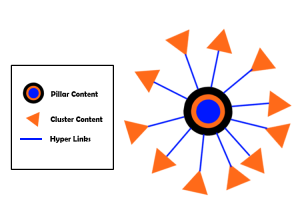
Contents
Introduction to Content Clusters and Pillar Pages
What are Content Clusters?
A content cluster refers to the arrangement of content on a particular topic around a pillar page. All such content pages are internally linked to their respective pillar pages. This structure helps the users of the website to easily access the relevant content. It also serves to convince the search engine that your website is a complete repository of knowledge on that particular topic. As an SEO Company in Kerala, we are sharing here some knowledge that we have understood and applied about Content Clusters and Pillar Pages.
Understanding Pillar Pages
Pillar pages are the centre of content that contains a comprehensive view of a topic. A pillar page serves as a bridge to its subtopic content pages. Pillar pages provide topic-related information in fewer words but more clearly and links to more detailed articles. Such pillar pages enable a better user experience and thereby boost your website’s SEO.

Why Content Clusters and Pillar Pages Matter in 2024
Improved User Experience
The content cluster method allows users to easily access topic and topic-related articles, which enhances the user experience. Consumers can absorb this organized information without scrolling through many pages. This feature keeps the users on the website for longer and thereby eliminates the bounce rate.
It is a fact that few web development and SEO companies in Kerala are aware of this treasure of content cluster even today. If you want your websites to have a better user experience, don’t forget content clustering.
SEO Benefits
Content clusters and pillar pages play a crucial role in increasing your website’s visibility and ranking. This structure makes it easier for search engines to crawl and index your website. Pillar pages and sub-topic content pages organized this way increase your uniqueness in the eyes of search engines. It will lead to improvement not only in your website ranking but also in heightening your site’s overall authority.
Internal Linking Strategy
Effective inbound links in content clusters play a crucial role in a website’s SEO. By linking an article and its pillar pages together, the search engine can easily understand the relationships between the various pages.
It helps to increase crawlability and make the search engine aware that your website is user friendly. As mentioned earlier, logical intent linking builds a website’s ranking, visibility, and authority.
Steps to Create a Pillar Page
Finding a main topic that can be divided into smaller sub topics is the first step to creating a pillar page Then write articles on these topics and link to their pillar pages. Make sure that the pillar pages are well designed and have comprehensive information about the topic. Pillar pages should contain attractive headings with internal links that can able to drive the user to the articles.
Building Supporting Content Clusters
An effective Content Cluster is to choose a subtopic as mentioned above. Make sure the topic is linked to the pillar page. Write a high-quality article on that subtopic that satisfies all the users’ queries. It is important to link each of these articles to the pillar page.
Tools and Best Practices
Tools like Trello, Asana, and Notion can be used to design Content Clusters. Draw pillar pages and related pages in a clear mapping. This will ensure that the pages are linked to each other. And mainly create high quality content. Make sure the anchor text provided by the internal linking is clear and strong. Constantly ensure the up-to-date relevance and freshness of the pillar page.
Content Clusters and Pillar Pages are also important factors in SEO in this 2024 era. Through this, it is possible to create a better user experience, SEO performance and well organized content. As a leading SEO and Website development Company in Kerala, we recommend Content Clusters and Pillar Page for long term SEO success. For more expert advice and services contact +91 844 844 0112




